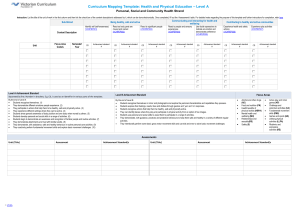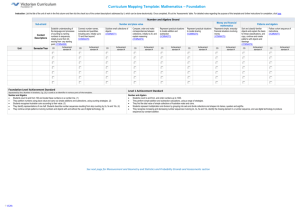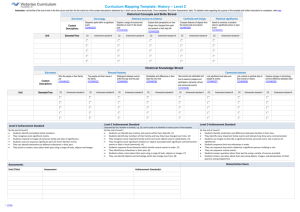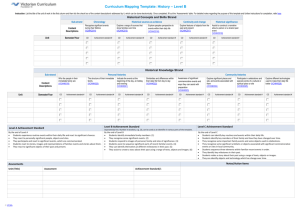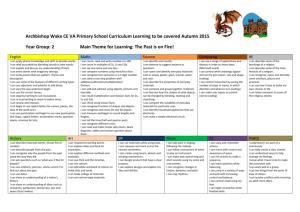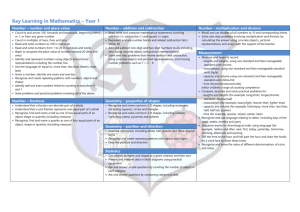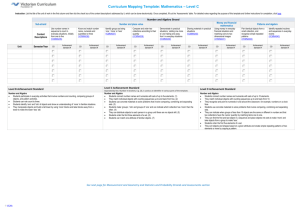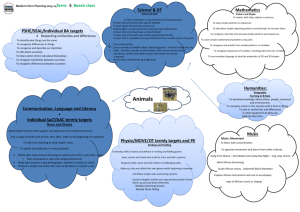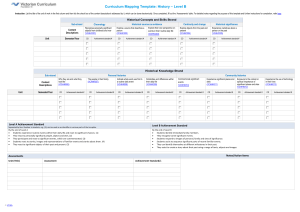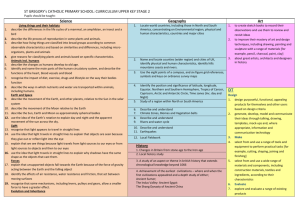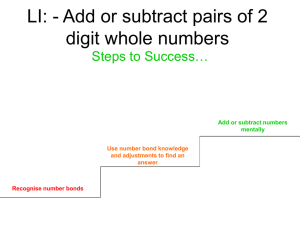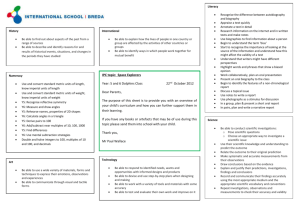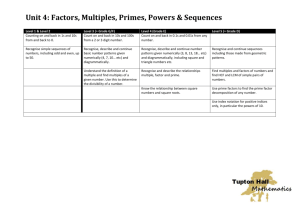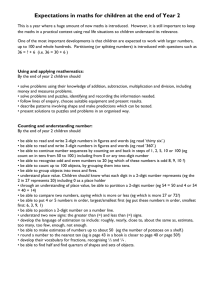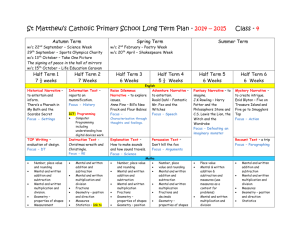Curriculum Mapping Template: Mathematics 1
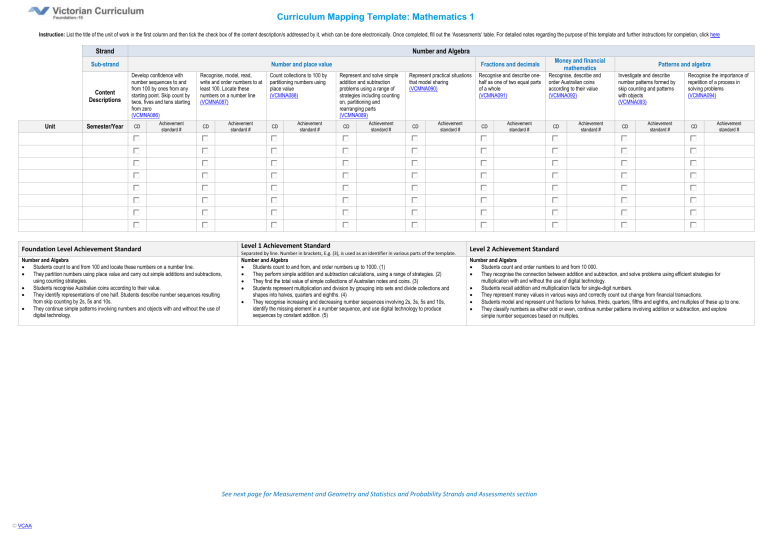
Curriculum Mapping Template: Mathematics 1
Instruction: List the title of the unit of work in the first column and then tick the check box of the content description/s addressed by it, which can be done electronically. Once completed, fill out the ‘Assessments’ table. For detailed notes regarding the purpose of this template and further instructions for completion, click here
Unit
Strand
Sub-strand
Content
Descriptions
Semester/Year
Develop confidence with number sequences to and from 100 by ones from any starting point. Skip count by twos, fives and tens starting from zero
(VCMNA086)
CD
Achievement standard #
Foundation Level Achievement Standard
Number and Algebra
Students count to and from 100 and locate these numbers on a number line.
They partition numbers using place value and carry out simple additions and subtractions, using counting strategies.
Students recognise Australian coins according to their value.
They identify representations of one half. Students describe number sequences resulting from skip counting by 2s, 5s and 10s.
They continue simple patterns involving numbers and objects with and without the use of digital technology.
Recognise, model, read, write and order numbers to at least 100. Locate these numbers on a number line
(VCMNA087)
Number and place value
Count collections to 100 by partitioning numbers using place value
(VCMNA088)
CD
Achievement standard #
CD
Achievement standard #
Represent and solve simple addition and subtraction problems using a range of strategies including counting on, partitioning and rearranging parts
(VCMNA089)
CD
Achievement standard #
Number and Algebra
Students count to and from, and order numbers up to 1000. (1)
Number and Algebra
Represent practical situations that model sharing
(VCMNA090)
Fractions and decimals
Recognise and describe onehalf as one of two equal parts of a whole
(VCMNA091)
Money and financial mathematics
Recognise, describe and order Australian coins according to their value
(VCMNA092)
CD
They perform simple addition and subtraction calculations, using a range of strategies. (2)
They find the total value of simple collections of Australian notes and coins. (3)
Students represent multiplication and division by grouping into sets and divide collections and shapes into halves, quarters and eighths. (4)
They recognise increasing and decreasing number sequences involving 2s, 3s, 5s and 10s, identify the missing element in a number sequence, and use digital technology to produce sequences by constant addition. (5)
Achievement standard #
Level 1 Achievement Standard
Separated by line. Number in brackets, E.g. (3), is used as an identifier in various parts of the template.
CD
Achievement standard #
CD
Level 2 Achievement Standard
Achievement standard #
Patterns and algebra
Investigate and describe number patterns formed by skip counting and patterns with objects
(VCMNA093)
Recognise the importance of repetition of a process in solving problems
(VCMNA094)
CD
Achievement standard #
CD
Achievement standard #
Number and Algebra
Students count and order numbers to and from 10 000.
They recognise the connection between addition and subtraction, and solve problems using efficient strategies for multiplication with and without the use of digital technology.
Students recall addition and multiplication facts for single-digit numbers.
They represent money values in various ways and correctly count out change from financial transactions.
Students model and represent unit fractions for halves, thirds, quarters, fifths and eighths, and multiples of these up to one.
They classify numbers as either odd or even, continue number patterns involving addition or subtraction, and explore simple number sequences based on multiples.
See next page for Measurement and Geometry and Statistics and Probability Strands and Assessments section
©
VCAA
Curriculum Mapping Template: Mathematics 1
Strand
Sub-strand
Content
Descriptions
Measure and compare the lengths, masses and capacities of pairs of objects using uniform informal units
(VCMMG095)
Unit Semester/Year CD
Achievement standard #
CD
Foundation Level Achievement Standard
Measurement and Geometry
Students identify measurement attributes in practical situations and compare lengths, masses and capacities of familiar objects.
They order events, explain their duration, and match days of the week to familiar events.
Students identify simple shapes in their environment and sort shapes by their common and distinctive features.
They use simple statements and gestures to describe location.
Statistics and Probability
Students sort familiar categorical data into sets and use these to answer yes/no questions and make simple true/false statements about the data.
Assessments
Unit (Title) Assessment
Measurement and Geometry
Using units of measurement
Tell time to the half-hour
(VCMMG096)
Describe duration using months, weeks, days and hours
(VCMMG097)
Shape
Recognise and classify familiar two-dimensional shapes and three-dimensional objects using obvious features
(VCMMG098)
Achievement standard #
CD
Achievement standard #
CD
Achievement standard #
(6)
They tell time to the half-hour and explain time durations. (7)
Students describe two-dimensional shapes and three-dimensional objects. (8)
They use the language of distance and direction to move from place to place. (9)
Statistics and Probability
Students describe data displays. (10)
They ask questions to collect data and draw simple data displays. (11)
Students classify outcomes of simple familiar events. (12)
Achievement Standard/s
Unit (Title)
Location and transformation
Give and follow directions to familiar locations
(VCMMG099)
CD
Level 1 Achievement Standard
Separated by line. Number in brackets, E.g. (3), is used as an identifier in various parts of the template.
Measurement and Geometry
Students use informal units of measurement to order objects based on length, mass and capacity.
Achievement standard #
Level 2 Achievement Standard
Measurement and Geometry
Students use metric units for length, area, mass and capacity.
They tell time to the nearest minute.
Students identify symmetry in natural and constructed environments.
They use angle size as a measure of turn in real situations and make models of three-dimensional objects.
Students match positions on maps with given information and create simple maps.
Statistics and Probability
Students carry out simple data investigations for categorical variables.
They interpret and compare data displays.
Students conduct chance experiments, list possible outcomes and recognise variations in results.
Assessment
Chance
Identify outcomes of familiar events involving chance and describe them using everyday language such as ‘will happen’,
‘won’t happen’ or ‘might happen’
(VCMSP100)
CD
Achievement standard #
Statistics and Probability
CD
Data representation and interpretation
Choose simple questions and gather responses
(VCMSP101)
Achievement standard #
Represent data with objects and drawings where one object or drawing represents one data value. Describe the displays
(VCMSP102)
CD
Achievement Standard/s
Achievement standard #
© VCAA Page 2
